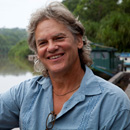
At a glance :
- Peatlands, mangroves and other tropical wetlands are high-Carbon ecosystems that are increasingly receiving recognition in the context of UN climate negotiations.
- Research was presented at a UNFCCC workshop in October to inform policy makers of the importance of including these ecosystems in strategies to mitigate and adapt to climate change.
- Knowledge gaps remain for reducing uncertainties about emission factors that are specific to the national contexts.
Scientists and climate change policy makers gathered at a workshop in Bonn last week to discuss the state of knowledge on “ecosystems with high-Carbon reservoirs not covered by other agenda items under the Convention [UNFCCC]”.
Behind that technical title lies an important development: high-Carbon ecosystems such as peatlands and mangroves are increasingly — and finally — attracting the attention they deserve in the international arena. More importantly, they are on the way to assuming their rightful place in countries’ climate change mitigation and adaptation strategies.
The workshop was organized by the UNFCCC/SBSTA (UN Framework Convention on Climate Change / Subsidiary Body for Scientific and Technological Advice), in response to a request by the Parties at last year’s Conference of the Parties to the UNFCCC in Doha, Qatar.
An “emission factor” is officially defined as “the average emission rate of a given GHG for a given source, relative to units of activity”. It can be understood as the change in the carbon stock caused by an activity. An example of an emission factor is the reduction in carbon per hectare of forestland when it is converted to crop land (e.g., 200 tons of carbon lost per hectare). For more information on emission factors, see Analysing REDD+: Challenges and Choices.
The purpose of the workshop was to raise awareness among UNFCCC climate change delegates of the values of these ecosystems — namely tropical peatlands, mangroves and other coastal ecosystems, temperate peatlands and permafrost ecosystems — given their large carbon stocks and potential emissions arising from land use change.
The Bonn workshop featured presentations by scientists from research institutions and intergovernmental organizations, all of who are working to provide credible, up-to-date scientific information on the dynamics of carbon stocks and greenhouse gas emissions from these ecosystems.
The workshop was especially timely in light of the adoption of the so-called “Wetlands Supplement”, formally the “2013 Supplement to the 2006 IPCC Guidelines for National Greenhouse Gas Inventories: Wetlands”, just one week earlier. The supplement was the result of three years’ work by scientists appointed by governments and observer institutions.
This sharpening focus in the UNFCCC and IPCC on tropical peatlands and mangroves has been made possible by recent advances in research demonstrating the values of these ecosystems. The Center for International Forestry Research and its partners, especially the US Forest Service under the USAID-funded Sustainable Wetlands Adaptation and Mitigation Program (SWAMP), provided significant relevant information for both the IPCC and UNFCCC processes.
We were also among those invited to the workshop in Bonn to present our findings for tropical peatlands and mangroves. The main messages we conveyed — and plan to keep on conveying — are that tropical peatlands and mangroves:
- have exceptionally high carbon stocks — among the highest of any ecosystem on Earth.
- are subject to alarmingly high rates of land cover change and deforestation because of agriculture and aquaculture developments.
- emit substantial amounts of greenhouse gases, which means their conversion results in a much greater decrease in carbon stocks than conversion of upland forests.
- provide numerous ecosystem services that are vital to the sustainability of local communities, livelihoods and infrastructure and
- The measurement (monitoring), reporting and verification (MRV) of the carbon stocks and emissions are now possible.
As we have argued elsewhere, these very values are why countries should include coastal wetlands and tropical peatlands in their mitigation and adaptation policies. With the kinds of data provided to the Parties to the UNFCCC at this workshop and elsewhere, countries can begin to do just that. The Wetlands Supplement will guide countries in better estimating greenhouse gas emissions and removals, according to IPCC Good Practice Guidance. Among the data presented at the workshop were the higher tier emission factors to be adopted for those estimations.
The IPCC takes a tiered approach to emission factors. Tiers represent the methodological complexity required to estimate the emissions and removals from an activity category (a category is an activity that causes greenhouse gas emissions, such as Fuel Combustion or Land Converted to Crop Land). Tier 1 is the simplest approach, where countries apply global default values; this approach is used for activity categories that do not have much influence on a country’s total inventory. Tiers 2 and 3 are for more important sources of emissions. They are progressively more sophisticated, using country- or region-specific data. Advances in research in recent years have made it possible for countries to use higher tier (Tier 2 or 3) emission factors for wetlands. These are included in the Wetlands Supplement. For more information on emission factors, see Analysing REDD+: Challenges and Choices.
The workshop also clearly revealed knowledge gaps. In particular, gaps remain for reducing uncertainties concerning emission factors that are specific to the contexts of the countries in which these ecosystems are found.
In addition, as our presentations showed, peatlands and mangroves offer services and benefits, especially for local communities, that have major economic, social and ecological values.
For example, these tropical wetlands provide a wide range of ecosystem services: not only do they regulate the climate by storing large amounts of carbon, they also provide food, fuel, fresh water and fibers and, in the case of mangroves, protect coastlines from high waves and storm surges. It’s plain to see, then, that tropical wetlands are of immense value to people not only for their carbon stocks and potential for climate change mitigation, but also for their potential to support climate change adaptation.
Once these ecosystem services are fully identified, monetary values can be assigned to them. This would make these ecosystems more attractive for climate change mitigation actions, and could provide a means by which the potential benefits and synergies between adaptation and mitigation actions within high-carbon ecosystems, now gaining recognition, could be truly realized.
We want you to share Forests News content, which is licensed under Creative Commons Attribution-NonCommercial-ShareAlike 4.0 International (CC BY-NC-SA 4.0). This means you are free to redistribute our material for non-commercial purposes. All we ask is that you give Forests News appropriate credit and link to the original Forests News content, indicate if changes were made, and distribute your contributions under the same Creative Commons license. You must notify Forests News if you repost, reprint or reuse our materials by contacting forestsnews@cifor-icraf.org.













